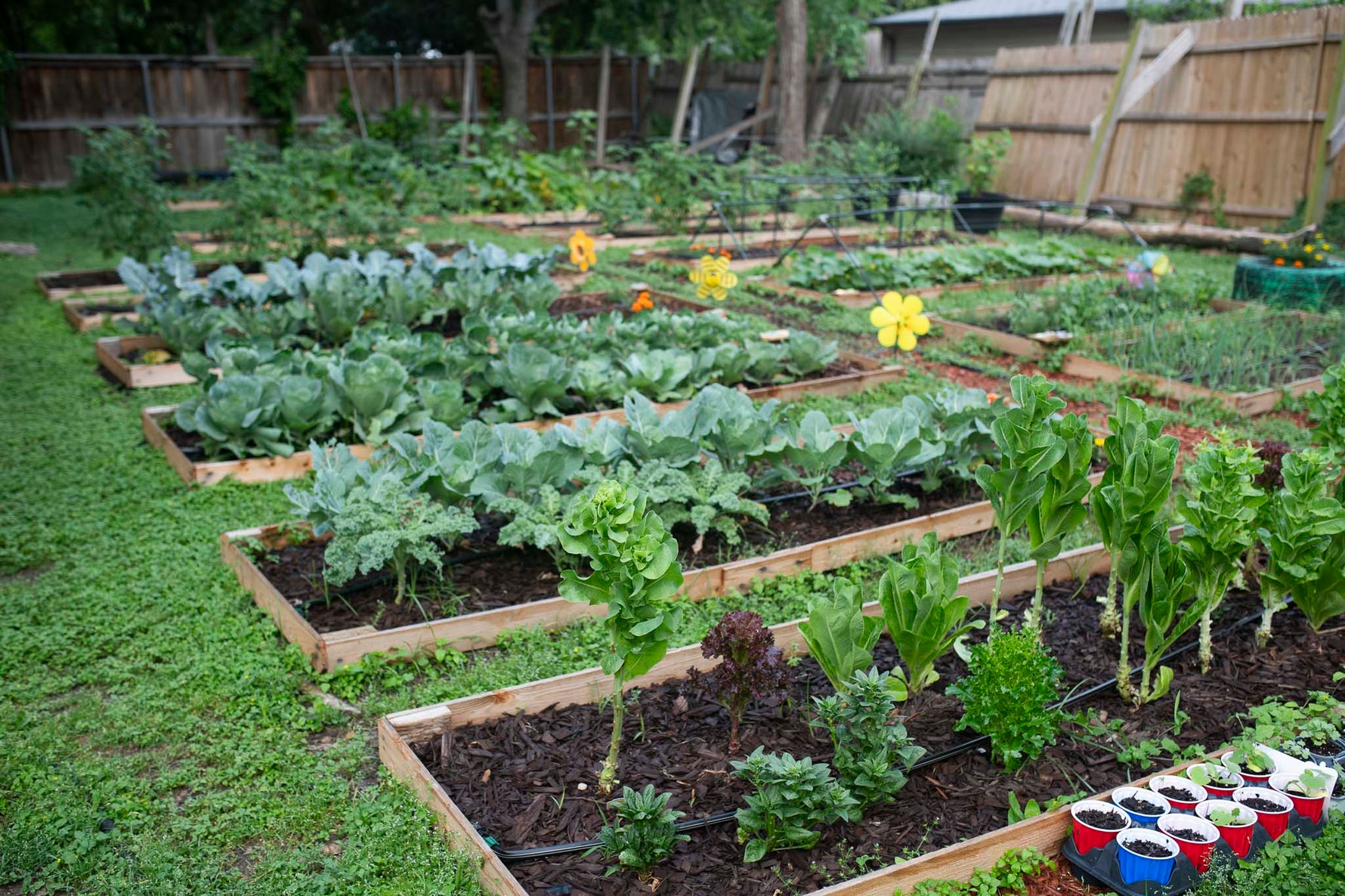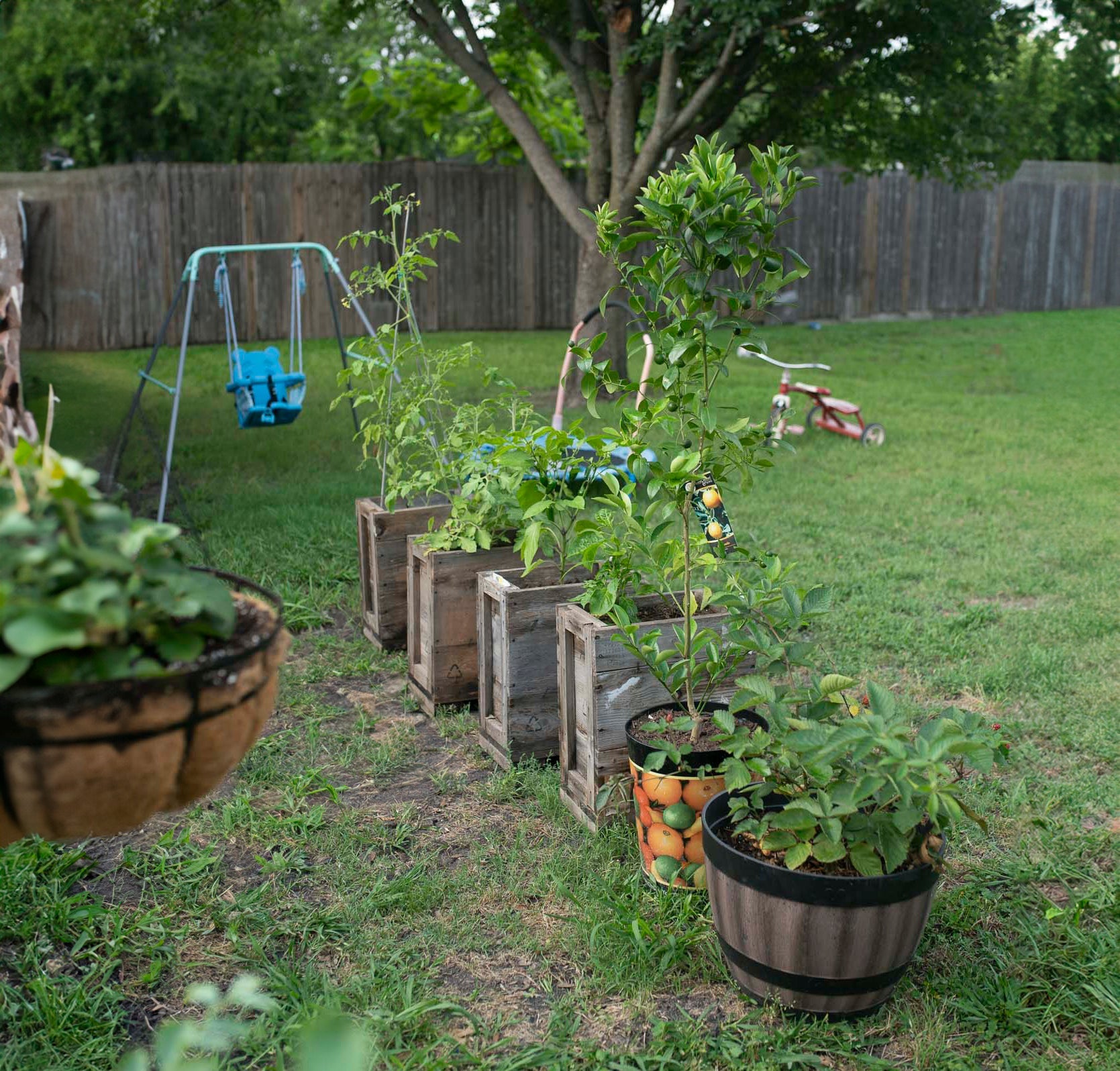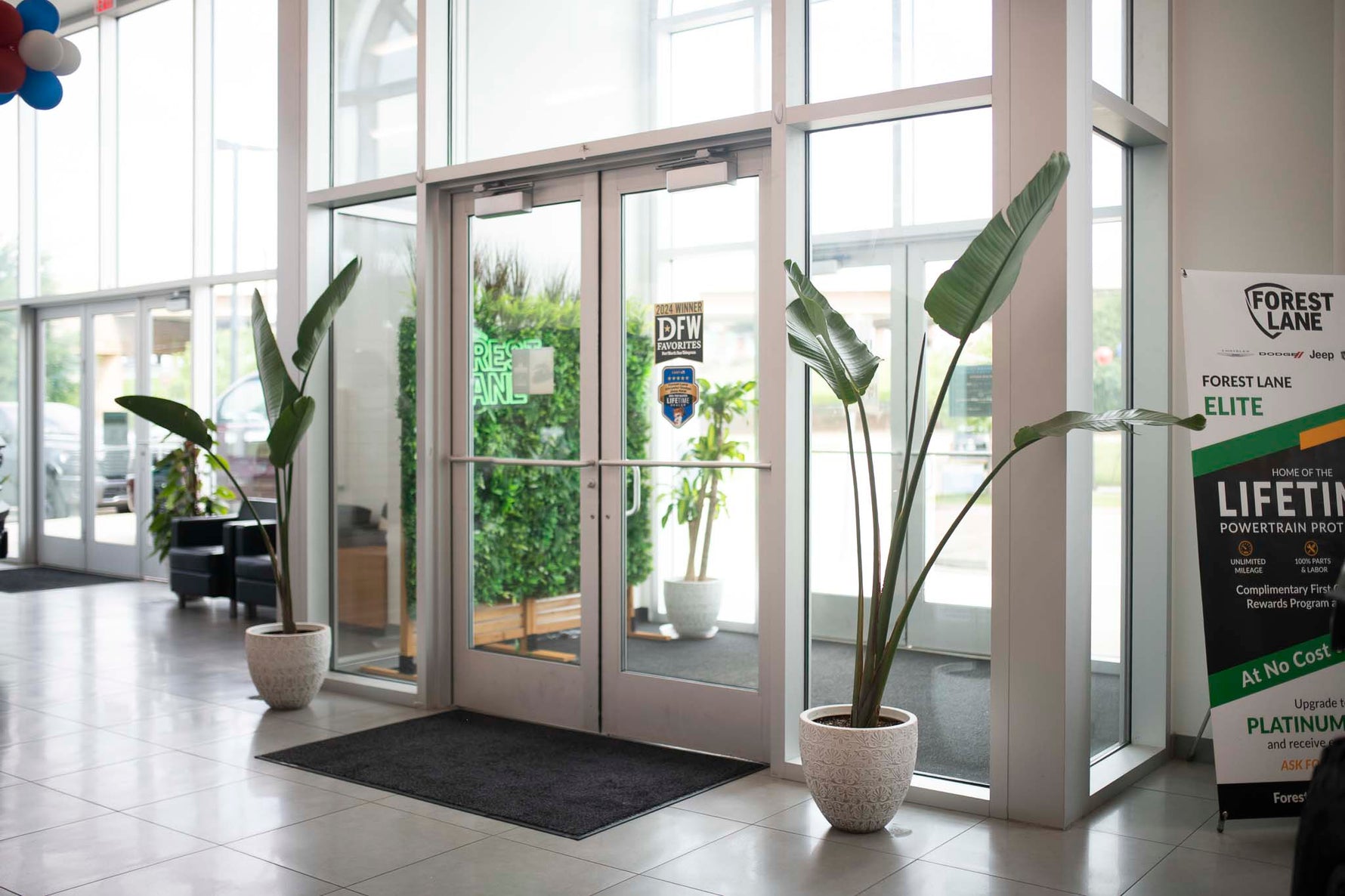News

News
A Backyard Garden Full of Surprises: Julie's Living Oasis
by Emily Bussey on May 29, 2025
"Gardens are not just about plants—they are an extension of our lives, our memories, and our creativity. A garden that reflects personal stories, like Julie's, creates a deeper connection between the space and its gardener. It transforms the garden into a living narrative, one that evolves with each season, just like the people who tend it."— Dr. Emma Greenfield, Horticultural Expert and Author of Gardens of the Heart*

News
Growing Independence: Matt Jaremko’s Backyard Mini Farm
by Emily Bussey on May 20, 2025
Growing Independence: Matt Jaremko’s Backyard Mini Farm
By Rooted in Kaufman
Step into Matt Jaremko’s backyard and you’re instantly transported to something between a homestead and a living classroom. Tucked into a quiet corner near Kaufman County, Matt has transformed his one-third-acre lot into a thriving, food-producing backyard farm—complete with vegetables, herbs, blackberries, and yes, even chickens.
This isn’t just gardening—it’s a full-on mission for self-sufficiency.
🥬 From Lettuce to Livestock: A Backyard Tour
Matt’s garden is carefully laid out in zones, with crops growing directly in the ground, in raised beds, grow bags, and even repurposed containers. It’s organized, productive, and deeply intentional.
“We’ve got lettuce, spinach, kale, collard greens, broccoli, cauliflower, bell peppers, tomatoes, hot peppers, squash, zucchini, cucumbers… the list goes on,” Matt says. “And the sweet potatoes? Those might be the easiest thing out here.”
His tomato beds are especially impressive, featuring both classic and cherry varieties for quicker harvests. Bell peppers and hot peppers are growing side by side, while squash and corn mingle in what he proudly calls his “Three Sisters” bed—a time-tested companion planting method used by Indigenous farmers where squash, beans, and corn grow together and help one another thrive.
🍓 Soil, Seeds, and Smart Strategy
Matt doesn’t just dump soil into boxes. “I’ve worked the actual soil underneath the beds,” he says. “Manure, compost, additives—every plant wants something different.” He’s done his homework, tailoring the soil composition to match each plant’s nutritional needs.
He starts many crops from seed—beans, onions, corn—while others come from starter plants. “I’ve got a mix,” he explains. “The goal is always to keep things growing and rotate with the seasons.”
He’s even growing blackberries from a plant he put in the ground five years ago. “It went crazy,” he laughs. “We had to take down the old fence because the vines took it over.”
🌞 Water, Bugs & Texas Heat: Real-Life Garden Lessons
Texas gardeners know water is everything, and Matt’s no exception. He installed a drip irrigation system and supplements it with hand watering. “The system helps, but I still like to water by hand so I know it’s getting where it needs to,” he says. “And in the summer, I’ll put up a 20-by-26 foot shade cloth to protect the more tender crops.”
For pest control? It’s essential oils. “I use rosemary oil, mint oil—natural stuff that works.”
And yes, there are marigolds and rosemary planted throughout the garden to deter pests, especially around his tomatoes.
🐔 Beyond Veggies: Chickens & Big Plans
The backyard also hosts chickens—just another step in Matt’s journey toward sustainable living. “Eventually I want a greenhouse. Maybe even a small farm,” he says with a grin.
The greenhouse is already in the works: a 20-by-15-foot structure where he’ll start seedlings in the early spring. “I started a bunch indoors this year, but I need more room. The greenhouse will be a game changer.”
🥗 Taste the Difference
When asked what tastes the best fresh from the garden, Matt doesn’t hesitate: “The lettuce. Hands down. It’s not bitter like the store stuff. And the herbs—we’ve already cut enough cilantro to make back what we spent.”
His wife takes fresh lettuce to work weekly, and with multiple harvests already behind them, the garden’s paying off in more ways than one.
🌱 Garden Wisdom from a Backyard Farmer
So what’s Matt’s advice for someone starting their own backyard farm?
“Water. That’s the biggest thing. In Texas, if you can’t keep it watered, it won’t grow.”
His second tip? Don’t be afraid to experiment. Raised beds, grow bags, direct planting—it’s all on display in his backyard, and each method has its place.
Most of all, Matt says it’s about learning as you go, and not getting discouraged. “Some stuff works, some doesn’t. You figure it out.”
From romaine to rosemary, Matt’s backyard is proof that with a little land, a lot of effort, and a bit of research, anyone can grow a slice of independence. And in a world of rising grocery bills and disappearing connection to our food—his message couldn’t come at a better time.

News
Backyard Abundance: A Family Garden Full of Heart
by Emily Bussey on May 20, 2025
Backyard Abundance: A Family Garden Full of Heart
By Rooted in Kaufman
If you ever find yourself daydreaming about a peaceful, productive backyard that brings generations together, Chris and Chelsea Jaremko’s garden is what that dream looks like. Nestled in their backyard, this edible oasis is more than just a patch of plants—it’s a place where strawberries are treasures, peach trees are milestones, and the grandkids always know where to find something sweet.
🌱 Growing Runs in the Family
Chris traces his gardening roots back to childhood, when his dad would till up a backyard plot for peppers, tomatoes, green beans, and okra. “It’s like it’s embedded in my DNA,” he says. That early exposure laid the foundation for what he and Chelsea are now cultivating—literally and figuratively—with their own family.
Chelsea’s first brush with gardening started when they bought their home and brought in a trailing vine plant that quickly took over the patio. “It was stressful,” she laughs, “but now it’s like, we can’t imagine not having plants.”
🍓 Why Peach Trees and Strawberries?
The couple’s current favorites? Strawberries and a peach tree. The strawberries have been a journey—early plants didn’t thrive, but with improved soil, better fertilizer, and a lot of trial and error, they’re now harvesting the best crop yet.
Chelsea picked out the peach tree for its beauty and resilience. “Peach trees can handle our winters,” Chris adds. “We love the idea of having homegrown fruit that sticks around year after year.”
🧒 A Garden Built for Grandkids
While the garden started with the couple’s own passions, it has naturally evolved into a haven for their grandkids. “We definitely had them in mind,” says Chelsea. Strawberries are a favorite snack, and the kids love discovering new things—sometimes a bit too early. “Our grandson called a tomato an apple,” Chris laughs. “And they love picking lemons even if they’re not quite ready.”
Their oldest grandchild has even helped plant and water the blueberries, and there's talk of a native wildflower section just for pollinators. “We’re planning a part of the yard we don’t mow for a while—just let the wildflowers take over,” Chris explains.
🌸 Lessons in Soil, Patience, and Surprise Dill
They’ve had their fair share of wins and setbacks. Dill, surprisingly, has thrived. “That thing went crazy,” Chris says. “I found fish fertilizer at Walmart and it changed the game.”
Strawberries, on the other hand, remain their trickiest plant. They’ve gotten better each year, but they’re still chasing that dream crop.
The couple has learned to research each plant’s soil needs and stay away from generic mixes. “Everything is unique,” says Chelsea. “You’ve gotta give each plant what it wants.”
🌼 What’s Next? Native Plants and Pollinators
Looking forward, Chris and Chelsea are excited to integrate more native wildflowers, both for the bees and for the Blackland Prairie ecosystem their yard sits on. “We want to use what naturally thrives here,” Chris says. “And if we can build soil with our own earthworms and compost, even better.”
They hope to eventually turn part of the yard into a native pollinator garden and line their back fence with flowers. “I want it to be full of blooms,” Chelsea says.
🪨 A Garden with a Sparkle
It’s not just plants that grow in Chelsea’s garden—her love of rocks and crystals brings another layer of beauty and personality to the space. A dedicated rockhound, she’s built a small rock garden using treasures collected from her travels, including crystals from Arkansas and Oklahoma and even geodes she found herself in the Oklahoma hills. The sparkling stones are nestled into flower beds and corners of the yard, catching the light and adding a touch of magic among the greenery. It’s a reflection of Chelsea’s curiosity and connection to the earth—and yet another reason their backyard feels so personal and one-of-a-kind.
💡 Advice for Families Starting Their Garden
When asked what advice they’d give someone wanting to build a small, kid-friendly garden, their answer is simple:Start with fruits and flowers.“Choose plants you can eat and see grow. There’s nothing like that feeling when something starts thriving.”
Chris adds, “When you’ve been struggling with a plant and it finally starts to take off—that’s the best feeling in the world.”

News
Native Plants in Kaufman Texas
by Emily Bussey on May 19, 2025
Why Native Plants Matter (Especially in Kaufman, TX)
Restoring beauty, biodiversity, and balance—one plant at a time.
Before highways, fences, and lawns filled the land, most of Kaufman County was part of the Blackland Prairie, one of the most ecologically rich and rare habitats in North America. This tallgrass prairie once stretched across North Texas, covered in a sea of wildflowers and native grasses—home to bison, quail, monarchs, and every buzzing, chirping, fluttering creature in between.
Today, less than 1% of this prairie remains.
But here’s the hopeful part: by planting native Texas plants, we can help bring a little of it back.
🌾 Why Native Plants?
Native plants are the ones that belong here. They’ve evolved for thousands of years to thrive in our climate, feed our wildlife, and support our soil. That makes them:
Low-maintenance (no fertilizer, no fuss)
Drought-tolerant
Loved by pollinators & birds
Supportive of local ecology
Resilient to Texas extremes
They’re not just beautiful—they’re purposeful.
🌱 The Blackland Prairie Legacy
Kaufman County sits squarely in Texas' Blackland Prairie ecoregion, known for its dark, clay-rich soils and tallgrass landscapes. This area was once bursting with life: Little Bluestem waving in the breeze, coneflowers blooming along buffalo trails, and prairie chickens calling from tall grasses.
Today, urbanization, farming, and invasive species have nearly erased it—but every time we plant a native grass, wildflower, or tree, we’re stitching a little of that lost habitat back together.
🌻 Our Favorite Native Plants for North Texas
🟩 Grasses (for structure, erosion control, and wildlife support)
Little Bluestem – A prairie classic with blue-green blades that glow rust-orange in fall.
Big Bluestem – Also called “turkey foot,” this tallgrass adds motion and majesty.
Sideoats Grama – Texas’ state grass! Drought-hardy and ornamental.
Eastern Gamagrass – Excellent for moist spots and wildlife shelter.
Buffalograss – Perfect for low-mow or no-mow lawns.
Gulf Muhly – Pink, feathery fall plumes = pure garden magic.
🌼 Wildflowers & Perennials (for pollinators + seasonal color)
Purple Coneflower – Classic native beauty, beloved by butterflies.
Indian Blanket – Drought-tolerant and cheerful.
Texas Bluebonnet – Our state flower, best planted in fall.
Black-eyed Susan – Bright and low-maintenance.
Winecup – A spreading groundcover with magenta blooms.
Horsemint – Fragrant and buzzing with bees.
Maximilian Sunflower – Tall, bold, and pollinator-friendly.
Gregg’s Mistflower – A monarch favorite with soft purple flowers.
🌿 Shrubs & Structural Plants
American Beautyberry – Stunning purple berries feed birds.
Agarita – Evergreen, fragrant, and thorny (a good barrier!).
Texas Sage (Cenizo) – Silver foliage and purple blooms after rain.
Elbow Bush – Great for screening; birds love the berries.
Flame Acanthus – A hummingbird magnet!
🌳 Native Trees of Kaufman, Texas
Shade & Canopy Trees
Bur Oak (Quercus macrocarpa) – Big leaves, massive acorns, and deeply drought-tolerant.
Post Oak (Quercus stellata) – Iconic Texas oak with thick bark; thrives in poor soils.
Shumard Oak (Quercus shumardii) – Great for fall color and larger landscapes.
Cedar Elm (Ulmus crassifolia) – Extremely drought-hardy, well-suited for urban yards.
American Elm (Ulmus americana) – Classic tall tree, now being replanted with resistant varieties.
Pecan (Carya illinoinensis) – Texas’ state tree; produces edible nuts and great shade.
Smaller Flowering & Ornamental Trees
Texas Redbud (Cercis canadensis var. texensis) – Beautiful spring pink flowers, heart-shaped leaves.
Mexican Plum (Prunus mexicana) – Early bloomer with fragrant white flowers.
Rusty Blackhaw Viburnum (Viburnum rufidulum) – More like a large shrub/tree hybrid; white spring blooms and fall color.
Eve’s Necklace (Styphnolobium affine) – Delicate, dark seed pods and small pink blooms.
Evergreens & Structural Trees
Eastern Redcedar (Juniperus virginiana) – Technically a juniper; great windbreak and wildlife shelter.
Ashe Juniper (Juniperus ashei) – A tough, small tree well-suited to dry, rocky spots.
🌱 Why Native Trees Matter
They’re drought-tolerant and disease-resistant
They provide habitat and food for native wildlife
They support soil health and reduce erosion
They require less water, fertilizer, and pruning than non-natives
🌱 Bonus Groundcovers
Frogfruit – Flowers, foot traffic–friendly, and native.
Snake Herb – Purple blooms and spreading growth.
🦋 Every Native Plant is a Step Toward Restoration
By planting even just a few native species in your yard, garden, or property, you’re helping:
Restore habitat for pollinators, birds, and wildlife
Improve soil structure and reduce erosion
Conserve water
Preserve Texas heritage
Support the survival of one of the most endangered ecosystems in the world
💚 Ready to Reclaim the Prairie (Even Just a Little)?
Come by Rooted in Kaufman—we carry many of the native grasses, shrubs, and wildflowers listed above. We're here to help you find the right native plants for your soil, sun, and style.
Let’s root Kaufman back in Texas, together.
If you're interested to learn more about the plants and animals that live in Kaufman county (invasive and native), let me introduce you to this website" https://www.inaturalist.org/places/kaufman-county

News
From Steel to Green: How Forest Lane Dodge Transformed Their Showroom with Live Plants
by Emily Bussey on May 14, 2025
🌿 From Steel to Green: How Forest Lane Dodge Transformed Their Showroom with Live Plants
When you think of a car dealership, you probably picture rows of shiny vehicles, bright overhead lights, and the scent of new leather—not lush greenery. But Forest Lane Chrysler Dodge Jeep Ram in Dallas is changing that.
With the help of Rooted in Kaufman’s commercial plant rental program, this dealership brought the outdoors in—and the results have been anything but ordinary.
🚗 Why Bring Plants Into a Dealership?
For General Manager Eddie Campbell, the decision was simple.
“I’ve always been a plant lover,” he said. “And when my friend Kyle brought up the idea of filling the dealership with live plants—and even taking care of them—I was all over it.”
While the dealership already had a few small plants, the goal was to elevate the entire space, giving it a more inviting, fresh, and natural feel. The change was immediate.
🌿 The Impact Was Instant—and Contagious
“The day the plants came in, the employees were already joking about stealing them and asking if they could take them home,” Eddie laughed.
But it wasn’t just the team that noticed. Customers were just as drawn in.
“I remember the first day a woman walked in and went straight to a plant to check if it was real,” he said. “It opened the door to a real conversation and made the whole experience more personal.”
One employee, Summer, a Sales Product Specialist at the dealership, agrees.
“Having plants in your home or business definitely elevates the atmosphere. It just... does something. It feels fresher, more alive, and it’s honestly beautiful to look at.”
🌱 A More Pleasant—and Productive—Work Environment
In a fast-paced setting like an auto dealership, creating a space that feels calm, fresh, and welcoming can make a real difference—for customers and staff.
“It classes the place up,” Eddie said. “It doesn’t feel like your typical dealership anymore. It feels like a nice office or even someone’s home.”
And while it’s hard to quantify atmosphere, the results speak for themselves.
“I really believe happy customers and happy employees lead to more business,” he added.
🛠️ Low Effort, High Reward
Rooted in Kaufman handles everything—from delivery and placement to ongoing maintenance. For Eddie, it’s a no-brainer.
“I don’t have to do anything except watch them grow.”
💬 Would They Recommend It?
Absolutely.
“I’ve already told other business owners about it,” Eddie said. “The energy changed immediately here. Why wouldn’t you want that in your space?”
Interested in Bringing Plants to Your Business?
Our commercial plant rental program offers:
Lush, healthy plants hand-selected for your space
Weekly maintenance and care
No hassle, all beauty
From offices and showrooms to salons and boutiques, plants make a difference—and we make it easy.
📍 Contact Rooted in Kaufman today to learn more about plant rentals for your business.

News
Texas-Tough, Heat-Loving Plants That Can Take the Heat
by Emily Bussey on May 13, 2025
Discover a vibrant lineup of perennials, shrubs, and edibles that thrive in Texas heat. From pollinator-friendly flowers to drought-tolerant vegetables, these Texas-tough plants are built to handle the sun and keep your garden blooming all summer long.
